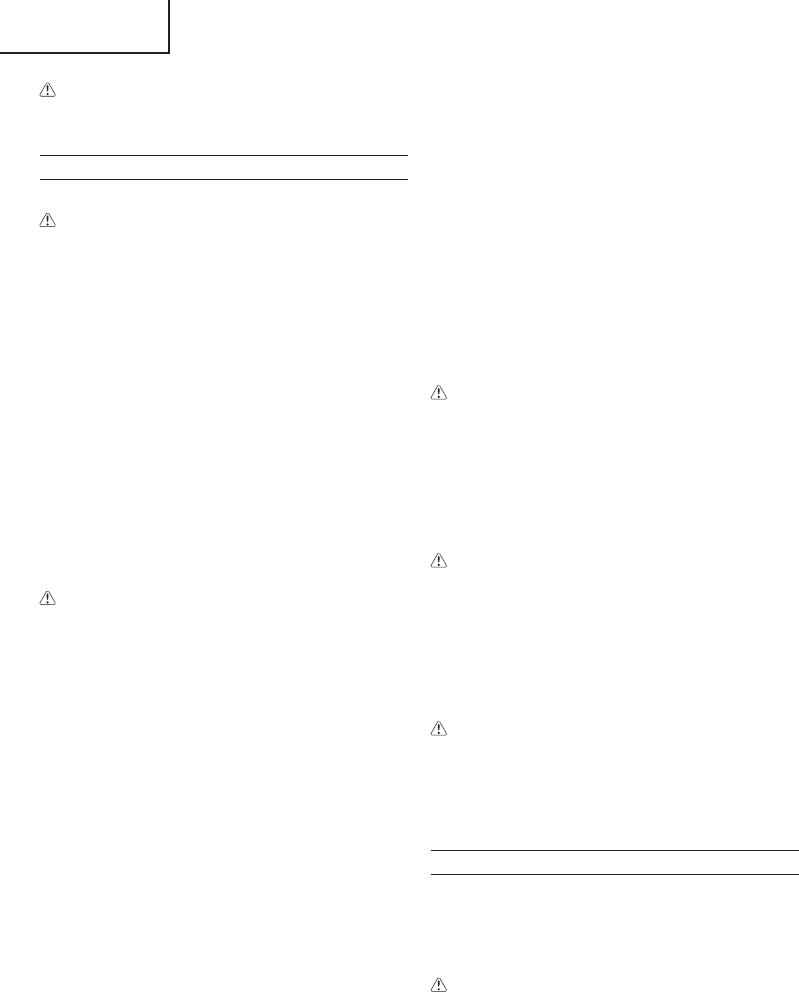
12
English
Cutting (Fig. 26, 27, 28)
○ When cutting, operate engine at over 6500 rpm. Extended time
of use at low rpm may wear out the clutch prematurely.
○ Cut grass from right to left.
○ Cut grass from left to right (only curve shaft model).
○ Blade thrust may occur when the spinning blade contacts a
solid object in the critical area.
A dangerous reaction may occur causing the entire unit and
operator to be thrust violently. This reaction is called blade
thrust. As a result, the operator may lose control of the unit
which may cause serious or fatal injury. Blade thrust is more
likely to occur in areas where it is diffi cult to see the material to
be cut.
○ Wear the harness as shown in the fi gure (if so equipped). The
blade turns counter-clockwise, therefore, be advised to operate
the unit from right to left for effi cient cutting. Keep onlookers out
of working area at least 15 m.
NOTE
Press the quick release button or pull emergency release fl ap
(If so equipped) in the event of emergency. (Fig. 27-1)
WARNING
If cutting attachment should strike against stones or other
debris, stop the engine and make sure that the attachment and
related parts are undamaged. When grass or vines wrap around
attachment, stop engine and attachment and remove them.
Stopping (Fig. 29, 30)
Decrease engine speed and run at an idle for a few minutes, then
turn off ignition switch (24).
For models with an engine ignition switch, keep the ignition switch
pressed until the engine comes to a complete stop.
WARNING
A cutting attachment can injure while it continues to spin after
the engine is stopped or power control is released. When the
unit is turned off , make sure the cutting attachment has stopped
before the unit is set down.
Semi-auto cutting head
○ When cutting, operate engine at over 6500 rpm. Extended time
of use at low rpm may wear out the clutch prematurely.
○ Cut grass from right to left.
○ Cut grass from left to right (only curve shaft model).
WARNING
A cutting attachment can injure while it continues to spin after
the engine is stopped or power control is released. When the
unit is turned off , make sure the cutting attachment has stopped
before the unit is set down.
Automatically feeds more nylon cutting line when it is tapped at low
rpm (not greater than 4500 rpm).
MAINTENANCE
MAINTENANCE, REPLACEMENT OR REPAIR OF THE EMISSION
CONTROL DEVICES AND SYSTEMS MAY BE PERFORMED
BY ANY NON-ROAD ENGINE REPAIR ESTABLISHMENT OR
INDIVIDUAL.
Carburetor adjustment (Fig. 31)
WARNING
○ The cutting attachment may be spinning during carburetor
adjustments.
○ Never start the engine without the complete clutch cover and
tube assembled! Otherwise the clutch can come loose and
cause personal injuries.
In the carburetor, fuel is mixed with air. When the engine is test
run at the factory, the carburetor is basically adjusted. A further
adjustment may be required, according to climate and altitude. The
carburetor has one adjustment possibility:
T = Idle speed adjustment screw.
WARNING
For Hitachi heads, use only fl exible, non-metallic line
recommended by the manufacturer. Never use wire or wire
ropes. They can break off and become a dangerous projectile.
OPERATING PROCEDURES
Fuel (Fig. 20)
WARNING
○ The trimmer is equipped with a two-stroke engine. Always run
the engine on fuel, which is mixed with oil.
Provide good ventilation, when fueling or handling fuel.
○ Fuel contains highly fl ammable and it is possible to get the
serious personal injury when inhaling or spilling on your body.
Always pay attention when handling fuel. Always have good
ventilation when handling fuel inside building.
Fuel
○ Always use branded 89 octane unleaded gasoline.
○ Use genuine two-cycle oil or use a mix between 25:1 to 50:1,
please consult the oil bottle for the ratio or Hitachi dealer.
○ If genuine oil is not available, use an anti-oxidant added quality
oil expressly labeled for air-cooled 2-cycle engine use (JASO
FC GRADE OIL or ISO EGC GRADE). Do not use BIA or TCW
(2-stroke water-cooling type) mixed oil.
○ Never use multi-grade oil (10 W/30) or waste oil.
○ Always mix fuel and oil in a separate clean container.
Always start by fi ling half the amount of fuel, which is to be used.
Then add the whole amount of oil. Mix (shake) the fuel mixture. Add
the remaining amount of fuel.
Mix (shake) the fuel-mix thoroughly before fi lling the fuel tank.
Fueling
WARNING
○ Always shut off the engine before refueling.
○ Slowly open the fuel tank, when fi lling up with fuel, so that
possible over-pressure disappears.
○ Tighten the fuel cap carefully, after fueling.
○ Always move the trimmer at least 3 m from the fueling area
before starting.
○ Always wash any spilled fuel from clothing immediately with
soap.
○ Be sure to check for any fuel leakage after refueling.
Before fueling, clean the tank cap area carefully, to ensure that
no dirt falls into the tank. Make sure that the fuel is well mixed by
shaking the container, before fueling.
Starting
CAUTION
Before starting, make sure the cutting attachment does not
touch anything.
1. Set ignition switch (24) to ON position. (Fig. 21, 22)
* Push priming bulb (25) several times so that fuel fl ows through
return pipe (39). (Fig. 23)
2. Set choke lever (27) to CLOSED position (A). (Fig. 24)
3. Pull recoil starter briskly, taking care to keep the handle in your
grasp and not allowing it to snap back. (Fig. 25)
4. When you hear the engine want to start, return choke lever to
RUN position (open) (B). Then pull recoil starter briskly again.
NOTE
If engine does not start, repeat procedures from 2 to 5.
5. Then allow the engine about 2–3 minutes to warm up before
subjecting it to any load.


















